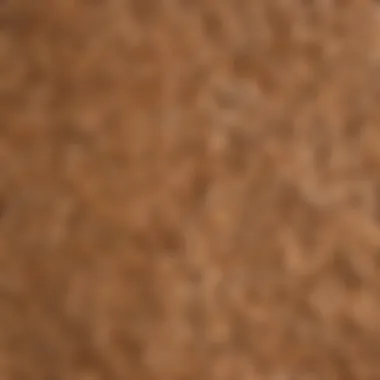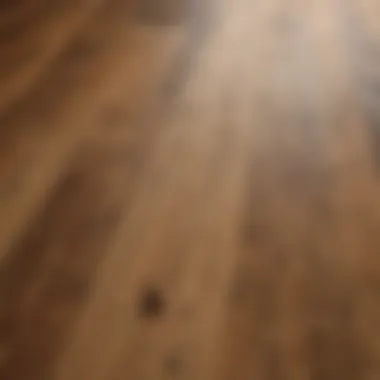Exploring OSB Flooring: Sustainable Solutions for Woodlands


Intro
In the quest for sustainable building materials, oriented strand board (OSB) flooring stands out as a compelling option. As woodland enthusiasts delve into various flooring solutions, understanding the nuances of OSB becomes essential. This material not only aligns with eco-friendly practices but also supports the idea of woodland stewardship—a concept increasingly significant in an age where environmental impacts are keenly felt.
OSB is crafted from strands of wood, which are bonded together using adhesives under heat and pressure. This process utilizes lesser-quality wood that would otherwise go to waste, making it not just functional but beneficial for the environment. Thus, it serves as an exemplary choice for those who care about forest management and the delicate ecosystems within them.
Let's journey through the wonders of OSB flooring, illuminating its characteristics, benefits, and applications within the context of sustainable forestry practices.
Prelude to OSB Flooring
Oriented Strand Board, commonly known as OSB, has emerged as a pivotal innovation in the realm of sustainable flooring materials. As the focus on eco-friendly practices intensifies, particularly among woodland enthusiasts, understanding OSB flooring's impactful role is essential. This section lays the groundwork for comprehending OSB's definition, composition, and history, correlating these elements with its sustainable merits.
Definition and Composition
OSB is a type of engineered wood product crafted from thin strands of wood, which are bonded together with adhesives to form a panel. These strands, made from renewable resources, are precisely layered and oriented in specific directions to enhance the board's strength and durability. One specific composition aspect is the thickness of the sheets, typically ranging from 10 to 25 mm, which provides versatility in applications.
This material stands out for its robustness when compared to traditional solid wood, owing to its meticulous bonding process. Besides, the production of OSB can maximize the use of forest resources, utilizing lower-grade wood that might not be acceptable for solid wood flooring. Indeed, OSB represents a remarkable blend of engineering and sustainability, showcasing how industrial processes can favor both efficiency and ecological welfare.
History and Development
The development of OSB has its roots back in the 1960s when the construction industry began to explore alternatives to plywood. Traditional wood products often faced limitations in availability and sustainability. Innovators in the lumber industry devised a method to produce boards from smaller wood particles.
Soon after, the material gained traction for its cost-effectiveness and structural integrity. Over the decades, advancements have significantly improved the manufacturing processes, allowing for greater precision in strand orientation and adhesive application. Manufacturing plants sprouted worldwide, contributing to the mass adoption of OSB among builders and designers.
By the late 1990s, OSB became one of the predominant products for structural flooring, walls, and roofs in residential and commercial construction.
"OSB, with its blend of strength and sustainability, has transformed flooring choices into something both practical and environmentally conscientious."
Today, OSB flooring is not just a construction material; it’s a conscious choice for those invested in sustainable woodland practices. It embodies an ethos of waste reduction while simultaneously prioritizing resource management, appealing to a generation that values responsible consumption.
In summary, the journey of OSB flooring from a mere alternative to a celebrated sustainable material reflects the industry's adaptive strategies in embracing environmental responsibility. Understanding its definition, composition, and historical trajectory will highlight the myriad benefits OSB flooring presents to the conscientious woodland enthusiast.
Sustainability Aspects of OSB
When diving into the world of OSB flooring, it’s imperative to emphasize its sustainability. The eco-conscious audience, especially woodland enthusiasts, deeply appreciate materials that align with their values. Here, we delve into the foundational elements that make OSB a standout option in sustainable construction.
Source Materials
OSB, or oriented strand board, is predominantly crafted from fast-growing tree species such as aspen and southern yellow pine. These woods, known for their rapid growth rates, are harvested selectively from sustainably managed forests. Unlike traditional hardwood flooring, which can result in the depletion of forest resources over decades, OSB promotes responsible forestry practices. The use of wood strands, which are often by-products from lumber mills, means that less desirable wood becomes valuable. This not only minimizes waste but also maximizes the usage efficiency of available resources.
Additionally, OSB can include recycled materials, enhancing its appeal as an environmentally friendly product. It’s not just about what’s being used but how those materials are sourced, ensuring that the impact on the forest ecosystems remains minimal.
Production Process
The production of OSB involves a sophisticated process that emphasizes both efficiency and sustainability. Once the wood strands are harvested, they are dried and arranged in layers, forming a mat. This layered approach enhances structural integrity while minimizing the amount of adhesive needed. In fact, the adhesives used in OSB production often contain recycled content themselves. During pressing, heat and pressure combine to cure the adhesive and bond the strands together, creating a strong and durable product.
It's worth noting that the manufacturing facilities are increasingly integrating energy-efficient practices. Many are employing biomass energy systems, which utilize waste by-products for power generation. This not only reduces reliance on fossil fuels but also lowers the carbon footprint associated with the production process.


Environmental Impact
The environmental impact of OSB is a mixed bag and warrants close examination. On one hand, its use of quick-growing species and waste materials ensures that fewer trees are felled unnecessarily. Moreover, OSB production is typically less resource-intensive than that of solid wood flooring. However, it is essential to consider aspects such as durability and lifespan, as a product that requires frequent replacement could counterbalance its initial set of sustainable benefits.
OSB has proven to be a reliable performer in various settings, especially in structural applications. However, its vulnerability to moisture can be a concern. Addressing this issue often involves the use of water-resistant treatments, which can have varying impacts on the environment. Thus, while OSB may come with certain drawbacks, framework from responsible sourcing to the production process helps mitigate many potential adverse effects.
"Sustainable choice isn’t just a trend; it’s a necessity for future generations, especially in woodland management."
Comparison to Traditional Flooring Options
When considering flooring options for projects rooted in sustainable practices, it’s essential to compare the characteristics, costs, and aesthetics of OSB flooring against more conventional materials. Theres much to mull over in this discussion as each choice can significantly affect both the environment—and the overall feel of a space.
Performance Characteristics
In the realm of flooring, performance is more than just a buzzword; it’s about durability, insulation, and structural integrity. OSB flooring, crafted from strands of wood bonded together with adhesives under heat and pressure, presents some commendable performance metrics.
- Strength: OSB is known for its impressive strength-to-weight ratio, often surpassing traditional plywood. It's engineered to hold up in demanding environments, be it a busy home or a commercial setting.
- Stability: The manufacturing process lends OSB enhanced stability. You might find it less prone to warping compared to conventional sawn wood flooring, which is often vulnerable to moisture and shifts in temperature.
- Thermal Efficiency: This material contributes to better thermal insulation, making spaces more energy-efficient. In contrast to standard hardwoods, OSB can help cut down on heating costs during chilly months.
One must also consider that OSB, while robust, exhibits different wear characteristics. It tends to show scratches more easily when compared to traditional hardwood or luxury vinyl tiles, which boast superior wear layers.
Cost Analysis
Delving into the financial nuances, OSB flooring often emerges as a financially savvy option. The initial investment in OSB can be significantly lower than traditional hardwood flooring, thanks to the more cost-effective sourcing of its materials.
- Initial Cost: Generally, OSB can be acquired for about 30-50% less than high-quality hardwoods. This is particularly enticing for large projects requiring extensive flooring.
- Long-term Investment: While the upfront costs may be enticing, it is crucial to consider long-term investments. If maintained properly, OSB can have a lifespan comparable to that of traditional options, especially in controlled environments. Repair costs, however, may accrue faster due to its susceptibility to moisture.
Despite its lower price tag, some might argue that OSB lacks the 'originality' factor associated with traditional wood flooring—an aspect often prized in high-end renovations. Here, it creates a bit of a pickle for consumers torn between appearance and functionality.
Aesthetic Considerations
When it comes to visual appeal, flooring choices often boil down to personal taste. OSB presents a unique aesthetic that sets it apart from more traditional offerings.
- Natural Look: The strand orientation creates a distinct texture and pattern, often favored in rustic or industrial-themed settings. This depth can contribute to a cozy ambiance—the kind that resonates with woodland enthusiasts.
- Finishing Options: With the correct finish, OSB can mimic the appearance of high-end wood floors. Whether you opt for a clear varnish to highlight the natural hues or a bold stain, the versatility is indeed striking.
- Flexibility in Design: Unlike traditional wood, which often adheres to specific designs and grain patterns, OSB can be used creatively in diverse formats—planks, panels, or even tiles.
Yet, it is important to note that some people prefer the rich, warm tones of solid hardwood or engineered floors. As a result, OSB might not appeal to those who are primarily motivated by traditional aesthetics.
In summary, while OSB flooring is emerging as a strong alternative to traditional options, customers must weigh performance, cost, and style based on their unique needs. Each flooring type has its own story—what will yours be?
Applications of OSB Flooring
The versatility of OSB flooring makes it an appealing choice for various environments. Understanding its applications not only illuminates its flexibility but also demonstrates how it aligns with sustainable practices in different sectors. The significance of OSB flooring extends across residential, commercial, and industrial uses, showing that if you’re looking for an eco-friendly material that doesn’t skimp on functionality, OSB has a lot to offer.
Residential Uses
In residential settings, OSB flooring stands out for its economical and practical attributes. Homeowners often lean on it as a cost-effective alternative to traditional hardwoods without sacrificing quality. OSB is particularly popular in new constructions and renovations due to its ease of installation.
- Durability and Stability: With proper installation, OSB provides long-lasting support. Its layered structure offers strength which can handle the wear and tear of daily life.
- Design Options: While OSB may not carry the classic appeal of cherry or oak, it can be finished and stained to match various interior designs, making it flexible in aesthetic choices.
- Eco-Friendly: For the conscious homeowner, using OSB can be a nod towards sustainability. Many manufacturers source their materials responsibly, often from managed forests, thus reducing the carbon footprint compared to traditional flooring options.
"Using OSB flooring is like supporting local ecosystems directly from your living room – a small step that has a significant impact."


Commercial Projects
When it comes to commercial applications, OSB flooring is frequently called to action in retail settings, offices, and more. It meets the functional demands of high-traffic areas with remarkable ease while staying budget-friendly for businesses.
- Functionality: The strength of OSB ensures it can withstand the heavy foot traffic often found in commercial environments. This durability translates into fewer replacements and lower long-term costs.
- Speed of Installation: In a business setting, time is money. OSB can be installed quickly, ensuring minimal downtime when revamping spaces or moving to new locations.
- Versatility: This flooring type can also be used beneath other surfaces like tiles or carpets, thus offering additional design flexibility for commercial spaces.
Industrial Environments
In industrial settings, OSB flooring isn’t just useful; it's often imperative. Factories, warehouses, and other heavy-duty operations benefit immensely from the robust traits of OSB.
- Heavy Load Support: OSB can support substantial weight, making it ideal for storage areas or machinery placements. It doesn’t warp easily under stress, a crucial factor in industrial settings.
- Ease of Maintenance: Maintaining cleanliness in industrial environments can be a chore, but OSB’s surface makes it relatively easy to clean and care for.
- Cost-Effectiveness: Given the constraints of tight budgets in many industries, the affordability of OSB allows businesses to allocate funds to other crucial areas without sacrificing quality.
In summary, whether it's your cozy home, a bustling commercial hub, or the demanding atmosphere of an industrial site, OSB flooring proves its worth. Its adaptability and sustainability make it a prudent selection for anyone looking to make educated and responsible choices in flooring.
Installation and Maintenance
Understanding installation and maintenance techniques is pivotal for anyone considering OSB flooring. This section navigates the intricacies of setting up and caring for this versatile material, emphasizing how proper practices ensure sustainability and functionality. The application of OSB flooring should be seen as a long-term commitment; hence, knowing how to install and maintain it is just as essential as recognizing its benefits.
Installation Techniques
When it comes to the installation of OSB flooring, precision and a methodical approach stand out. Unlike traditional hardwood, OSB requires a slightly different technique largely due to its composition. Here are some key points to consider:
- Subfloor Preparation: Prior to laying down the OSB panels, ensure the subfloor is clean, dry, and level. Any debris or bumps can throw off the final look and durability of the surface.
- Acclimatization: It’s vital to allow the OSB to adjust to the room’s temperature and humidity before installation. This step helps mitigate future expansion or contraction, which could lead to unsightly gaps.
- Nailing and Gluing: Use a combination of nailing and engineered adhesives to secure the OSB panels in place. This dual support system enhances stability. Typical nail lengths range from 1.5 to 2 inches, optimizing hold without compromising integrity.
- Expansion Gaps: Maintain appropriate expansion gaps around the perimeter and between panels. This consideration avoids pressure build-up which could warp the structure over time.
Following these techniques not only aligns with industry standards but also underpins the flooring's durability, creating a seamless finish that complements any woodland setting. The connection between installation practices and sustainability cannot be overstated.
"Proper installation not only extends the life of OSB flooring but also prevents the need for frequent replacements, thereby supporting eco-friendly principles."
Maintenance Practices
Maintaining OSB flooring doesn’t require advanced skills but does demand regular attention to detail. A well-maintained floor can last well beyond its expected lifespan and contribute to a more sustainable environment. Below are several maintenance practices that woodland enthusiasts should adopt:
- Regular Cleaning: Sweeping and dusting should become part of your routine. Utilize a soft-bristled broom or a vacuum designed for hard surfaces to avoid scratching the board. Applying a damp mop can assist in lifting any stubborn dirt without leaving excessive moisture behind.
- Moisture Control: Given the moisture sensitivity of OSB, it’s essential to manage humidity levels within indoor environments. Aim to keep relative humidity between 30% to 50%. The use of dehumidifiers in particularly humid climates can prevent damage.
- Immediate Repairs: Any signs of wear—like scratches or chipped edges—should be addressed promptly. For minor scratches, a blend of wood filler can help restore the surface. Just be sure to seal it with an appropriate coating that matches the finish.
- Regular Inspections: Periodically check for signs of moisture damage, warping, or mold growth. Early detection of such issues can prevent larger, more costly problems down the line.
In summary, the installation and maintenance of OSB flooring is not merely a task; it’s a commitment to a sustainable choice that aligns with woodland stewardship. Taking your time in installing and regularly maintaining OSB will surely pay off, ensuring that your flooring stands the test of time while highlighting your dedication to preserving our natural resources.
Potential Limitations of OSB Flooring
When considering OSB flooring, it is crucial to assess its limitations, as understanding these factors contributes to making informed choices in sustainable building practices. While OSB has its fair share of advantages, certain drawbacks may affect its application in specific contexts. This section highlights some of the most significant limitations related to durability and moisture sensitivity while providing insight into how these issues might impact woodland enthusiasts and professionals involved in forestry or eco-conscious projects.
Durability Concerns
Durability is a pressing concern for many when comparing flooring options. OSB flooring is manufactured to be strong and resilient, yet it does come with some caveats. Its durability can be compromised under certain conditions, particularly in high-traffic areas or when subjected to heavy loads over time. Unlike solid hardwood, which ages gracefully and retains strength, OSB may suffer wear-and-tear more quickly if not properly protected.
The composition of OSB can make it susceptible to damage from impacts. A dropped heavy object can leave a dent or even crack the board. Furthermore, while OSB is generally strong, it does not possess the same inherent structural integrity as traditional hardwood, which might lead to concerns about long-term use, especially for those aiming for longevity in their flooring choices.
"Choosing OSB flooring for areas expecting heavy usage might seem like a sound decision, but understanding its limitations is key to avoiding future headaches."


Moisture Sensitivity
Another important consideration is moisture sensitivity. OSB boards are usually made from wood strands that are glued together with resin, which can make them more vulnerable to moisture than traditional wood flooring. When exposed to high humidity or unnecessary moisture, OSB can swell, warp, or even lose structural integrity. For woodland settings, where humidity levels can fluctuate, it's vital to ensure that the OSB is sealed appropriately to mitigate moisture-related issues.
In environments where water damage is a possibility, such as basements or bathrooms, the risks associated with OSB flooring compound even further. The resin used in OSB does not always perform well against water penetration compared to other flooring materials. This can lead to potential mold growth—a concern for both health and structural integrity.
To manage moisture sensitivity in OSB, it's advisable to take preventive actions:
- Proper Sealing: Use high-quality sealants to protect the surface from moisture.
- Adequate Ventilation: Ensure proper air circulation to reduce humidity around the flooring.
- Regular Maintenance: Inspect for signs of moisture damage periodically.
In summary, while OSB flooring can be a sustainable choice for many applications, its potential limitations regarding durability and moisture sensitivity demand careful consideration and proactive management. Balancing these concerns with the benefits of OSB can guide woodland enthusiasts toward more informed decisions.
Future Trends in OSB Flooring
The landscape of flooring materials is rapidly changing, and OSB flooring is no exception. As the demand for sustainable building practices grows, staying ahead of trends is crucial for anyone involved in forestry management or construction. Knowing where OSB flooring is headed can not only influence purchasing decisions but also shape how future projects are designed. Embracing these trends ensures that woodland enthusiasts can maximize the benefits of OSB while adhering to environmental stewardship principles.
Innovative Manufacturing Techniques
One of the key factors driving the evolution of OSB flooring is the introduction of innovative manufacturing techniques. These methods don't just enhance the quality of the boards; they also contribute to sustainability. For instance, advances in adhesives have made it possible to reduce the toxic chemicals traditionally used in OSB. New formulations based on bio-based materials offer a path towards less environmental toxicity.
Moreover, production processes are increasingly energy-efficient. Machinery that utilizes less energy while producing OSB boards allows manufacturers to meet rising demand without exacerbating resource depletion. Many companies are now exploring techniques such as hot pressing and improved strand orientation, leading to a stronger product that performs better under stress. These enhancements contribute to a lower overall environmental footprint, aligning OSB production with veterans of the sustainable materials movement.
"Innovations in the production of OSB not only improve performance but also address environmental concerns, heralding a new era for sustainable construction."
Market Growth Projections
When analyzing the future of OSB flooring, one cannot overlook the substantial market growth projected for the next decade. Various industry reports suggest that the demand for sustainable building materials, including OSB, is set to expand significantly. This is largely attributable to shifting consumer preferences and stringent regulations advocating for eco-friendly construction practices.
Key factors contributing to market growth include:
- Increased Awareness: Consumers and builders are more educated about environmental impacts, gravitating towards sustainable options.
- Regulatory Changes: Governments across the globe are enacting laws favoring greener building materials, making OSB a go-to choice for compliant projects.
- Innovation Demand: There's a growing appetite for innovative products that blend aesthetics, durability, and sustainability, placing OSB in an advantageous position within the market.
Fluctuations in pricing and supply issues may pose challenges, but overall, the outlook for OSB flooring remains bright. Forest management professionals need to keep their ears to the ground, as understanding these market dynamics can significantly influence procurement strategies, project planning, and even marketing approaches.
In summary, the future of OSB flooring is poised to embrace advanced manufacturing processes that enhance quality and sustainability, alongside predicted market growth that could see OSB becoming a cornerstone in eco-friendly building practices. Understanding these trends will empower forestry professionals and enthusiasts to make informed choices that align with both environmental values and market conditions.
The End
The discussion surrounding OSB flooring is not just an exploration of a material, but a deeper understanding of its role in sustainable forestry practices and woodland management. This conclusion emphasizes the value of OSB in contemporary applications while also hinting at its broader environmental significance.
Summarizing the Value of OSB
OSB flooring stands out for multiple reasons. It is a composite material made from strands of wood, bonded together with adhesives to form a sturdy board. This composition allows it to be an economical alternative to traditional hardwood flooring, often at a fraction of the cost. Its production process utilizes smaller trees, helping to alleviate the pressure on old-growth forests. More importantly, OSB is a testament to modern engineering that maximizes the use of harvested timber, promoting a sustainable approach to forestry.
In terms of performance, OSB offers durability comparable to solid wood flooring while remaining lighter and easier to handle during installation. Its versatility is exemplified by its varied applications, whether in homes, commercial spaces, or industrial environments. As woodland enthusiasts are often concerned about environmental impacts, OSB presents a responsible choice that aligns with their values. The ongoing advancements in manufacturing techniques continue to enhance its sustainability profile, which enhances its attractiveness as a viable flooring option.
"Investing in OSB flooring not only furthers personal comfort but also honors eco-conscious choices in woodland stewardship."
Call to Action for Sustainable Choices
As we conclude, it’s clear that choosing OSB flooring can have a significant impact on both personal spaces and the environment. It’s not merely about picking a material; it’s about making a statement and taking steps toward responsible consumption. Here are some ways to engage further with sustainable choices:
- Research Local Suppliers: Seek out local manufacturers who adhere to sustainable practices. This fosters local economies and reduces transportation emissions.
- Consider Certification: Look for OSB products that are certified by recognized organizations like the Forest Stewardship Council (FSC), which ensures responsible sourcing.
- Educate Others: Share your knowledge about OSB and its sustainable benefits with peers. Awareness is a powerful tool in promoting eco-conscious decisions.
- Explore Alternatives: While OSB is an excellent choice, explore other sustainable flooring options to widen your perspective on what responsible flooring looks like.
By taking these steps, woodland enthusiasts can contribute to a broader movement towards sustainable forestry and eco-friendly construction. Making informed choices about flooring is not just a task; it’s a commitment to the wellbeing of forests and the environment as a whole.







